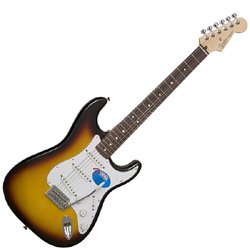The first prototypes of the Gibson Flying V Guitar were made in 1957 to compete with the Fender Stratocaster, which was very popular at the time. Gibson wanted to create a guitar that had a design that looked great and something that would look like it came from the future. They did exactly that by designing a guitar that looks like something that would be in a Jetson's cartoon. Another futuristic model that they created at the same time was the Gibson Explorer.
1958 was the year that the Flying V hit the stores but with a few changes that made them different from the prototypes. The prototypes were made of mahogany, which made them too heavy for Gibson's liking. They changed the wood to korina wood, which was similar to mahogany but lighter.
These new models didn't fly off the shelf like Gibson had hoped they would and dealers in all of 1958 and 1959 ordered less than 100 of them. This led to the Flying V being discontinued and left out of the Gibson catalog in 1960.
As we all know, even though it was discontinued, this was not the last we would see of the Flying V. So what happened? Well a couple of amazing guitarists, Albert King and Lonnie Mack, really loved the sound and the looks of the guitar and continued to use them as their main instruments. These guitarists influenced a lot of the up and coming guitar players and the Flying V caught their eye as well. Interest was really starting to grow so Gibson decided to bring it back.
Gibson returned the Flying V into production in 1966 and went back to using mahogany wood, added a bigger pick guard and changed to a Vibrola tailpiece. Some records show that only 175 Flying V's were made between 1966 and 1970.
In the late 60's, Jimi Hendrix began using Flying V's and one of his most popular guitars was the first one he got where he hand painted some psychedelic artwork on it. Jimi is also known for his sunburst and left-handed models.
In 1971, Gibson release a limited run of 350 Medallion Flying V's. These featured a two-piece body, a three-piece neck, a shorter headstock and a stop bar tailpiece instead of the Vibrola. These guitars were so popular that they sold out in their first year.
In the mid 70's, thanks to heavy metal bands like UFO and the Scorpions, the Flying V was producing massive sales with the Flying V Mahogany.
Gibson came out with the famous Flying V2 in 1979 which featured "boomerang" style pickups and brass hardware to improve sustain. Only 157 of these guitars were shipped the first year and they were more expensive than the earlier versions.
Other guitar companies like Dean, Hamer and Ibanez were selling cheaper versions similar to the Flying V design, so Gibson released the Flying V CMT in 1981.
In the 1990's, Gibson released a series of artist signature models for Jimi Hendrix, Lonnie Mack and Rudolf Schenker. In 2002, they came out with a Lenny Kravitz Signature 67 Flying V.
Even though the Gibson Flying V guitar had a rough start earlier on, today the guitar is one of the most sought after models ever. Some of the guitarists that have made the Flying V famous are Albert King, Lonnie Mack, Jimi Hendrix, Billy Gibbons, Rudolph and Michael Schenker, Kirk Hammett, Pete Townshend, Lenny Kravitz, Yngwie Malmsteen, K.K. Downing, Rick Nielsen and Eddie Van Halen.
"Teach Yourself Guitar The EASY Way" - grab your FREE report that Reveals "How to Avoid the Top 7 Mistakes That Most Beginners Make When Buying a Guitar Learning Product"
http://teach-yourself-guitar.com/freereport
aluminium fender stratocaster

